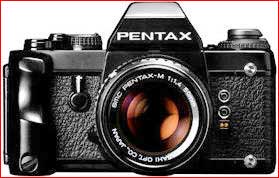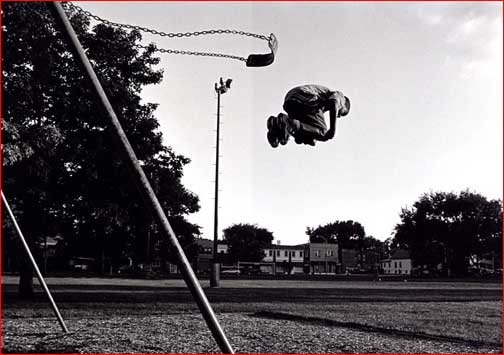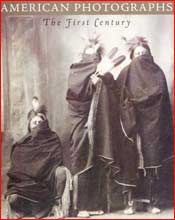The Public and Me:
What’s an SLR Supposed to Be?
I’ve been reviewing cameras professionally since 1988 — mostly 35mm SLRs, the more expensive 35mm rangefinders, and all types of medium format cameras. I’ve never tried to compile a list of all the cameras I’ve had extensive experience with — meaning a minimum of three weeks of concerted shooting time — but it’s between 40 and 50, and it includes cameras made from the early 1950s up until today. This is not counting the ones that I try for just a day or two. That’s cheating. My feeling has always been, and still is, that a reviewer should use a camera for several weeks to be able to tell anybody anything intelligent about it, something above and beyond mere opinion.
I take a lot of ribbing for my sentimental affection towards "metal, mechanical, manual" SLRs. In truth, though, I don’t really have a beef against polycarbonate, micro-motors, batteries, or AF. I confess I rather like the Canon Rebel G, the Pentax ZX-5n, and the Nikon N80. My objection is more to the implementation we get than the technology that’s used.
Car analogies are easy, but consider the way cars are sold. Certain assumptions are made — in some cases justifiably — about who buys them and why. I personally like sporty small cars. (Just so long as the insurance industry doesn’t classify them as "sports cars," that is.) And I’m really not unhappy with the options we get in the compact, economy car class — current technology for the price, as with cameras, is pretty amazing.
But I want the good engine and a stick shift.
I’m not sure what the situation is today, because I’m pretty happy with my present econocar. But I know that in the past, I’ve had trouble buying cars. For starters, many "good" cars don’t even have a manual transmission as an option. Rule them out. Next, to get the best engine option in an econobox, you also often have to buy the "deluxe" variant of a model — meaning you then also get to pay for a sunroof, the gratuitous disturbance-of-the-peace package (a.k.a. car alarm), pin-striping and/or whitewalls, the dopey "spoiler" glued to the trunk lid, and whatever other cruddy gewgaws the marketers consider "luxurious." Worse, in some cases, if you get the best engine, you often have to take an automatic transmission along with it! Catch-22 for me.
The analogy falls down, because we really do have a lot of options with cars. I believe there are currently 455 models of cars available on the world market. Our choice among cameras is more limited. Basically, you either get small and light but cheap, or good but big and heavily laden with features. There’s not much in the way of small and light and good.
My Two Hats
As a camera reviewer and also a photographer, I’ve got to wear two hats. There are the things I like objectively, as a reviewer, on behalf of other people, based on what I’ve learned from other photographers, and there are the things I like for myself. According to manufacturers’ market research, the public and I diverge over what is currently needed and wanted in a 35mm film camera. I also distinguish between objective and subjective criteria. There are some things that I believe are basic — that distinguish between good and not-so-good implementation. Then there are subjective criteria, or matters of personal taste.
What the public appears to want in an SLR is for it to be:
- cheap
- feature-laden, but with easy-to-use "dummy modes" so they don’t have to learn to use all those features
- portable and easy to carry (and did I mention "cheap"?)
Whereas what I value is:
- a good view, meaning it enables you to see clearly what you’re shooting
- responsiveness, meaning it quickly and surely does what you tell it to
- a control set that is possible to master.
Those are the objective criteria. Now on to matters of taste. Here’s what the public subjectively prefers:
- great big horrible cheap-ass slow-as-shit zoom lenses
- flip-up flashes, so they don’t have to remember to bring the flash along
- completely automatic metering, so they never have to learn "Thing 1" about exposure
- AF, preferably in a lot of different spots so they never have to decide what to focus on.
Here are a few things I like:
- Quiet operation (I do a lot of candid shooting)
- fast primes (I almost never use flash)
- a light meter that lets me in on what it’s thinking — and AE lock, so I can tell it to stop helping once I think we’ve got it right
- good manual focus ability or override
- ruggedness and durability.

What the heck ist this?
I shoot Pentax, and two things that have just happened have highlighted, for me, the divergence between what the public wants and what I want. First, Pentax is just about to debut a fantastic little camera called the *ist. It will be the smallest, lightest AF SLR in Creation, yet it has a formidably long list of features. Strange name — it’s pronounced "ist," the asterisk being silent, and here’s what Pentax says about it:
"This is the new brand name of Pentax SLRs, combining the asterisk, which is one of the wild card characters in the computer language, and the English suffix -ist which means people who do or believe in certain things. The * can be replaced by various words, composing, for example, Artist, Liberalist, Idealist, Naturalist, Humanist, etc. The *ist was named in tribute to those who have their own ideals and live a proactive life." (Thanks to Ken Takashita for providing this information.)
So what did I do? I went and got myself an LX.
The LX, for those of you who aren’t familiar with it, was the last truly professional camera made by Pentax. It came out in 1980, and was a contemporary with the Nikon F3. Unfortunately, it was never updated.

What did I go and do? Talk about being contrary….
I hope to enjoy it, but I also must admit that it’s probably my last hurrah with Pentax. If it’s not reliable for me, or I have problems acclimating to it, I’m not going to beat myself bloody trying to keep my nice SMCP-M lenses. I’ll just keep my ES II and its three screwmount lenses as souvenirs, and move on.
The Pentax "PJ"
My needs in a camera are pretty simple, I think. I need a basic camera with an excellent viewfinder, good responsiveness, reasonable quietness, and a few basic features like aperture-priority AE, manual settings, and an AE lock (not present on the LX, by the way, but I’ll use exposure compensation and see how that goes).
I like the Nikon FM3a and N80. The Contax Aria is probably going to be doomed eventually, and Contax doesn’t have the lenses I need, but I could make do with it. I’m not going to get a Leica M7 because of its cost, but I could live happily ever after with a Hexar RF. I don’t think I care for any current Canons.
And although I really like 35mm best, I could probably also make the paradigm shift to the Bronica RF645 I wrote about last week.
I’ve given Pentax a good shot. I’ve used a number of Spotmatics, the K2, the ME Super, and the ZX-5n. I’ve borrowed an MZ-S from a kind friend and, while I admire it and certainly have no quarrel with those who love it, it’s not the box for me. I’ll give the LX a good solid shot before I bail.
I guess my basic problem here is that I don’t think Pentax has any intention of serving my niche in the future. What’s my niche? I guess photojournalism of the slice-of-life daily documentary sort, with fine-art leanings. Oh, a good friend at Pentax keeps hassling me (in a friendly way — he’s a great guy) about my fondness for metal cameras, but I’m not really asking for one of those. I know they’re not cost-effective any more, and that they don’t sell. The camera I want — let’s call it the PJ, for photojournalist — could be polycarbonate, and AF, and move the film with motors. But I need a viewfinder as good as the Aria’s, low shutter lag, and low noise. And those three features — aperture-priority AE, manual, and AE lock. Size and weight? Not the biggest. Not the smallest. But just right. The size and weight of the LX would be fine.

What’s my niche? Photojournalism of the slice-of-life daily documentary sort, with fine-art leanings.
I think I’ll actually like the *ist. It looks like a cool little box. It’s very highly specified for such a tiny, inexpensive camera. Wearing my reviewer’s hat, I think people are really going to like it, and I bet it will be popular. But wearing my photographer hat, what I want for myself is probably about the opposite of the *ist. Something stripped down in terms of features, but of good quality in the basic build. A working tool. A polycarbonate, AF Spotmatic in spirit! No, notthatstripped down, but you get the point.
A camera with no flip-up flash, just a hot shoe. Not made for flash. Three AF points would be plenty — I could live with one. A quiet shutter rather than a high-speed, high-sync one. Center-weighted metering, maybe spot metering too, although I don’t insist, but no onboard computer deciding how it wants to tweak the exposure…especiallyif it doesn’t tell me what it’s up to! (One of the best features of the Aria is that it tells you in the finder how its multi-segmented evaluative metering is departing from a centerweighted reading).
And instead of all the money getting put into a zillion features out the wazoo, put all the money into the basic build. A good big glass viewfinder. Robust film transport. A really good meter. Great battery life.
You know…as if the only thing I wanted to do was take pictures.
— Mike Johnston
Do you appreciate "The Sunday Morning Photographer"? Neither Mike Johnston not I make anything from presenting it. It’s here with no strings attached. Should you wish to support it, please check out thislink.
SMP Book of the Week

American Photographs:The First Century by Merry A. Foresta.1996, Smithsonian Institution Press, ISBN 1-560987-18-9 (cloth) 1-560987-19-7 (paperback). Designed by Steve Bell, printed by Stinehour Press.
This week, a favorite book of mine, and one I think is recommendable even if you don’t much care for 19th century photography.
This one is a remainder, meaning that it’s done with its sales life and the remaining stocks are being cleared out. It should cost you a princely ten bucks if you can find it. It’s a lovely survey of photography’s first century by Merry Foresta, curator for photography at the Smithsonian’s National Museum of American Art. The illustrations cover a wide range and Foresta’s scholarship is impeccable. Overall, the book is virtually a model of what an exhibition catalog should be.
Gradings:
- Content: B (A if you like historical photographs)
- Reproduction quality: A
- Presentation: A
- Bookcraft: B+
- Synergy and intangibles: B+
Overall Rating:***(four if you collect books about photo history)
Mike Johnstonwrites and publishes an independent quarterly ink-on-paper magazine calledThe 37th Framefor people who are really "into" photography. His book,The Empirical Photographer, is scheduled to be published in 2003.
You can read more about Mike and findadditional articlesthat he has written for this site, as well as aSunday Morning Index.
You May Also Enjoy...
Slot Canyon Images of The Southwest
By Ben Hattenbach The images are enlargements from the images used to illustrate Ben's Articles Slot Canyon Images of The Southwest Copyright 2009 Ben Hattenbach
